"How about we sign up for the 10K marathon in Quebec City this August?" Chantal asked me one afternoon.
"Are you silly?" I replied. "It's terrifying!"
"Come on, we can do it. We have seven months to train—plenty of time for a short 10K."
August felt far away, and the idea of shedding a few extra pounds twirled in my mind. After a brief pause, I said, "Hey, why not? Let’s do it."
The next day, I joined the local YMCA. After the initial instructions from the trainer, I stepped onto the treadmill. It had been a long time since I’d done any kind of physical activity. Four minutes later, huffing and puffing, I stepped off.
"This is going to be a challenge," I told myself.
Surprisingly, each visit added a few more minutes to my endurance. By May, I was jogging on Circle Summit—a 1.5 km loop on Mount Royal. Two loops became three, and soon enough, I started looking forward to my runs. After work, I’d change into my running gear and head to the top of the mountain. It felt good; it became therapeutic.
Unfortunately, Chantal backed out of our deal. But there was a silver lining: my 21-year-old son, Kevin, agreed to run with me. We ran side by side, joking about who was the bigger fool—the young guy who hadn’t trained at all or the 51-year-old who had only started running a few months prior. We finished the 10K in just about an hour, and that day, running became a passion.
On September 10th, I ran the Montreal Half Marathon in 1 hour and 59 minutes. Crossing the finish line at the Olympic Stadium, with little tiredness felt good.
After that, running became almost a daily ritual. Mount Royal’s wooded trails turned into my sanctuary. Birds chirped, leaves crunched underfoot, and I exchanged nods with passing joggers and dog walkers.
Then came an idea: why not incorporate half-marathons into my travels? I started checking marathon calendars in Europe, the USA, and Canada. A race, a cultural escape, and a few days off work—what could be better?
While researching, one race caught my eye: the Milano City Marathon on Sunday, October 8th, 2006. Less than a month away. Could I? Should I? What was stopping me?
I clicked “Register”. Only, there was a catch: no half-marathon option—just the full 42 km. Disappointed, I called the info line. In my best Italian, I explained my situation. The woman on the other end listened, paused, and then said softly, "Listen, this marathon is only open to full marathoners. But if you really want to participate, register for the full marathon and stop whenever you want."
That night, I dreamt of running through the streets of Milan. The next morning, I booked my flight and intensified my training.
I landed in Italy on October 3rd, and before heading to Milan, I visited the region of Trentino and Lago di Garda. I arrived in Milan just after lunch on October 7th. I had booked a room in a small hotel about five kilometers from Piazza del Duomo, where the starting line was located. I checked in, settled into the tiny hotel room, and headed to the official Marathon site to pick up my T-shirt, bag of goodies, and, of course, the traditional pasta meal supplied by the organizers. Unlike in Quebec or Montreal, where the pasta arrives pre-cooked in large black bags, strained quickly in hot water, and served with a cup of canned tomato sauce, this was a state-of-the-art meal.
I slowly made my way through the line toward the Barilla van, transformed into a terrace-style bistro. To my surprise, I had a choice of spaghetti, rigatoni, or fusilli, with sauces ranging from salsa marinara to rosé. The pasta was cooked fresh right in front of me. Each portion was then placed in a small pan on a gas-fired stove, sizzling with sauce, where it finished cooking to perfection. Al dente, hot, with freshly grated Parmigiano sprinkled on top.
I returned to my hotel, convinced that a good night’s sleep was what I needed. Yet, my mind refused to settle, tossing and turning for what felt like hours.
When the alarm rang at 6:00 AM, I had already been awake for a while. The quick shower felt refreshing, fully waking me up. I ate a bowl of fruit salad, grabbed a croissant and a cappuccino, and headed to the subway—a route I had carefully studied the evening before. By 7:15, I arrived at the runner’s campsite. Large tents sheltered runners who carefully and slowly prepared themselves. This was only my third time running in an organized race, but this felt different. The men around me were meticulous about their appearance. For a moment, I wondered if they were heading to a fashion show or preparing to run 42 kilometers.
It was a sunny and chilly autumn morning. Fortunately, large plastic ponchos were offered, and I grabbed one to stay warm. Slowly, I made my way toward the starting line, passing in front of the majestic Gothic cathedral, Il Duomo di Milano, the largest church in Italy.
The starting area was divided into multiple zones, called Corrals, each designated by colored flags representing different projected finish times. I found the Green Flag, which corresponded to runners aiming to finish around four hours.
With twenty minutes left before the start, I felt happy, excited, and anxious to get going. Around me, runners of all ages spoke Italian, German, Spanish, French, and many other unidentifiable languages. A young Italian man next to me was on the phone with his mother, giving her a play-by-play of the departure atmosphere. Another runner held a sign that read, “Ciao Nonna.”
My registration papers read: Tino Masecchia, Canada. Canada? I thought to myself. I felt so at home that “Canada” sounded distant. Proudly wearing my official marathon jersey with tag number 4232, I prepared for the unknown. Twenty-one kilometers or perhaps more—I had no idea what my body would endure. But I promised myself that I would push as far as I could, and if collapse felt imminent, I would quietly and bravely walk to the nearest subway station and return to my hotel.
I never heard a pistol or horn signaling the start of the race, but the crowd around me started moving, and so did I. I was running in Milan. Earphones in, I pressed play on my carefully curated marathon playlist. The music was designed to build motivation progressively over four hours. Taking those first steps on the pavement of Via Borgogna felt exhilarating. The collective energy, adrenaline, and nervous excitement of thousands of runners surrounded me.
After a few hundred meters, the crowded pack began to thin, and by the one-kilometer marker, I had enough space to settle into my pace. The hazy, humid air typical of Milan gave way to a light blue sky, bathing the city streets in a serene glow on this early Sunday morning. By the second kilometer, most of the yellow ponchos, including mine, lay discarded on the roadside. I felt strong, confident, and proud to be running through the streets of this beautiful city—the home of AC Milan, the soccer team I had cheered for since I was six years old.
The music playing in my ears felt slower than my body wanted, so I clicked the skip button on my iPod until I landed on a faster beat. I stopped on the song “Crazy” and thought it was quite fitting. A passing runner smiled at me, and I realized I had been loudly humming to the music.
The five-kilometer banner appeared, and I grabbed a glass of water from a volunteer-staffed table. The cheers from the crowd and volunteers felt like little bursts of energy. My body felt strong, and running felt natural and effortless. I was the luckiest man on earth.
At the ten-kilometer mark, my watch showed 59 minutes. Slightly ahead of my usual pace, I noticed the 4-hour pacemaker, or "Rabbit," nearby. These runners, easily identifiable by their banners or clothing, set a consistent pace for their goal time. Running close to them felt like setting cruise control in a car.
“Ciao, bella giornata! Come vanno le gambe?” (Hi, nice day, how are the legs holding?) I asked a woman running alongside me. We chatted about the city, running, our professions, and our shared mindset of stopping only when our bodies said, "enough." We lost sight of each other just before the 20-kilometer marker.
I refocused on my running as the water I’d been drinking began to push on my bladder. I’m not sure how it’s done in other cities or countries, but in Montreal, I can assure you that people use the blue portable toilets lined up along the course. Here, men stopped behind trees, cars, fences—anything that offered even partial cover. Well, when you’re in Milan, you do as the Milanesi do.
I proudly ran past the 21-kilometer marker. Although fatigue was beginning to creep in, there was no way I was stopping now. I could feel the sun getting warmer on my face. I wasn’t exactly sure where we were, but it felt like we had left the busy city center and entered a suburban neighbourhood with narrow roads and large empty fields. By the 25th kilometer, we were back in the hectic energy of Milan, and that’s when the tiredness started to be felt. My legs grew heavier, my feet barely lifted off the ground, and my pace slowed considerably. Still, I was confident I could make it to 30K. A few orange slices, a concentrated energy gel from my back pocket, and a drink of water gave me a much-needed boost. Yet, the 28K marker felt like it would never arrive.
At 29 kilometers, exhaustion hit me hard. My feet dragged, and every step felt monumental. Maybe this is what they call hitting The Wall, I thought.
Between kilometers 29 and 30, I faced a decision: Should I stop? After all, I had already run nearly nine kilometers more than I ever had before—far exceeding my expectations. Walk off the course, Tino, my inner voice urged. You did it. Don’t be foolish. But there was another voice, quieter but more persistent—the voice I had planted weeks ago when I signed up for this race. The one with an image of me crossing the finish line in front of Il Duomo. And so, began the classic mental tug-of-war: rational versus emotional. Most people know me as cautious and level-headed, yet so many of my life’s decisions have been driven by emotion rather than reason. I wasn’t about to quit now. I wanted to cross that finish line.
If I was going to make it, I had to adjust. At the 30K marker, I decided to walk until kilometer 31. Walking felt like a relief. My body was exhausted, but my mind remained unyielding. Eleven kilometers to go—three-quarters of the race was behind me. I could do this. After a brief pit stop and a sugar square, I resumed running before even reaching the 31K point.
That’s when I felt something in my body I’d never experienced before. My joints felt stuck, as if pistons in an engine were grinding metal against metal without oil. Just as my rational side prepared to convince me to quit, something shifted. My joints began to loosen, and fluid seemed to return to my legs. And so, I continued.
An elderly woman appeared beside me, running at about my pace. She was from England, and she mentioned her husband was far ahead. “We must stay in tune with our bodies and our minds,” she said, her words gentle but firm. “We need to recognize our strength.” Was this a message meant for me? Our brief chat distracted me from my pain and gave me renewed focus.
At kilometer 34, I saw the five-hour pacer bunny glide past me at what felt like an impossibly fast speed. Or maybe it was just me slowing down. I had to stop running again, but I never stopped walking. My feet kept moving forward, step after step. I was determined to finish—even if I had to crawl across the finish line.
Further ahead, I overheard a familiar dialect. Two men, about my age, were shuffling along at a slow but steady pace. I joined them and asked where they were from. “Fiuggi,” one replied—a town about 45 minutes north of my birthplace. They thought my accent was strange and couldn’t pinpoint its origin. “You’d never guess,” I said, laughing. “It’s a mix of Ciociaro, (my dialect) French, and English.” One of them chuckled, “Ah, so you’re an immigrant.” I smiled. “I’m Canadian at heart, but Italian blood still flows in my veins. You can change your home, but not your heritage.” They picked up their pace, while I held back to conserve enough energy for the final stretch.
At kilometer 37, I alternated between walking and running. When I finally spotted the 38K marker, a rush of adrenaline surged through me. My strength now came purely from my mind, as my body was screaming in protest.
At kilometer 40, I repeated to myself: Every step brings you closer. The crowd grew denser, and I began to see the iconic silhouette of the Duomo in the distance. The cheers from the crowd became a distant hum as my focus narrowed to one single goal: the finish line.
I pushed my body to its limits, every step carrying the weight of exhaustion and the lightness of determination. And then, I saw it—the finish line. My right foot crossed the final rubber speed bump, and I heard my name echo through the loudspeakers in Piazza del Duomo.
“Tino Masecchia, Canada.”
I made my way to the cathedral steps and sat down, quietly weeping in gratitude, relief, and pride.
The official time: 5:22:55. Position: 2112 out of 2149.

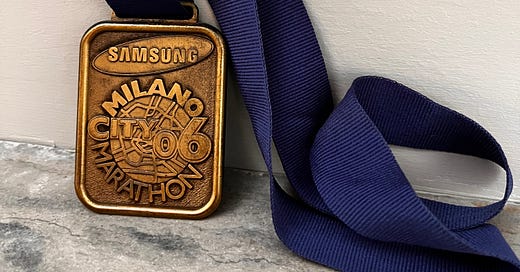



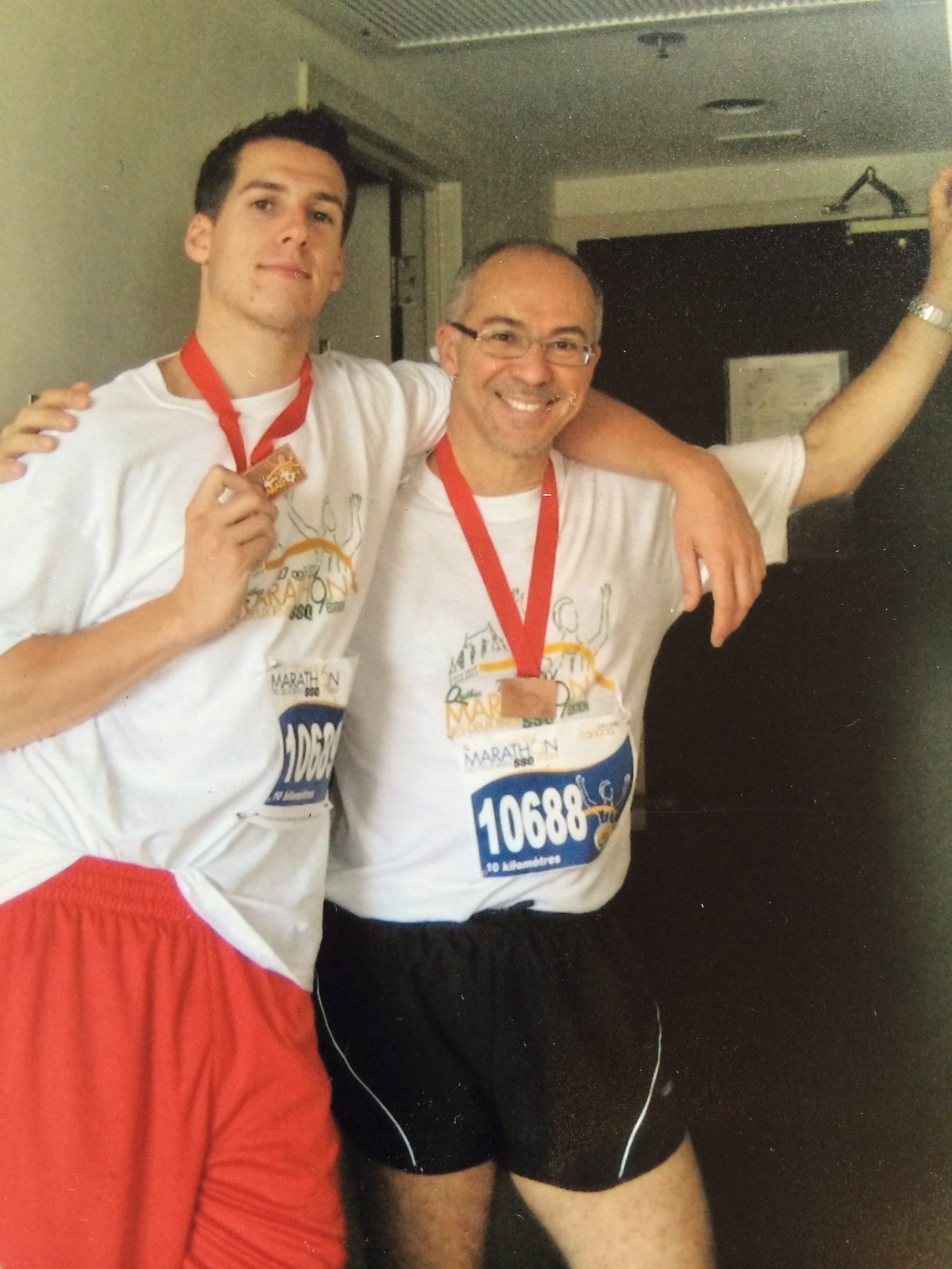

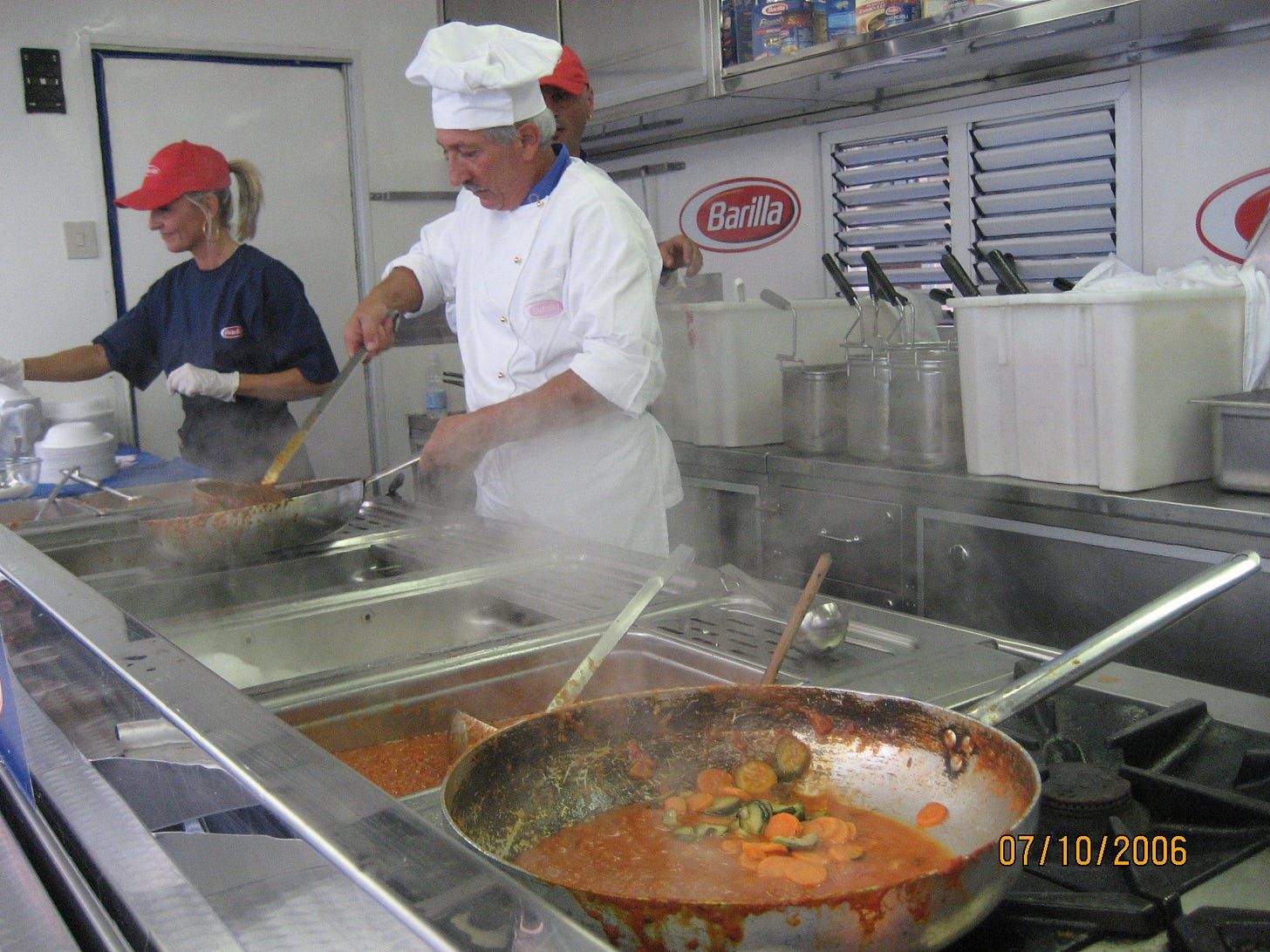

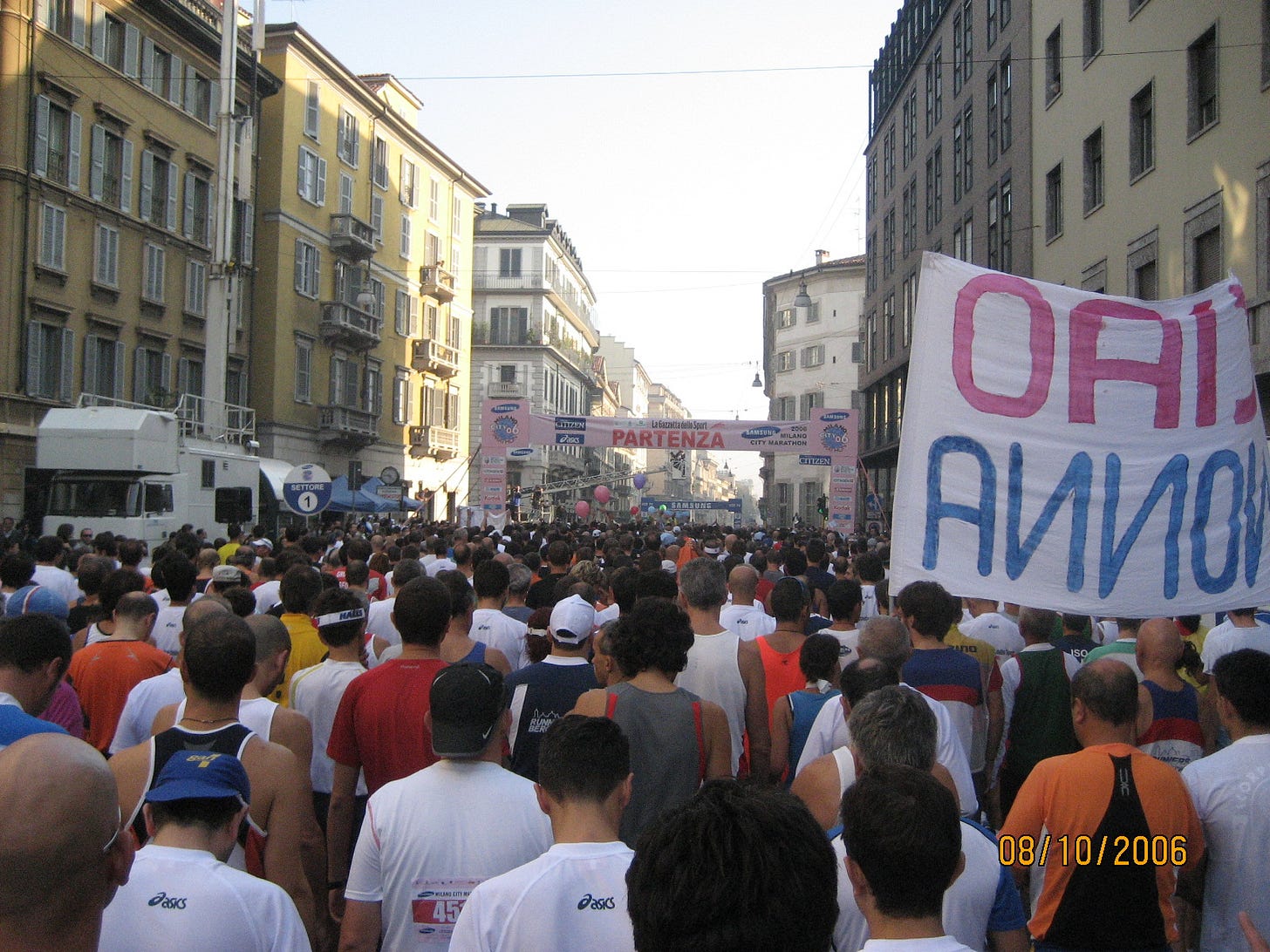
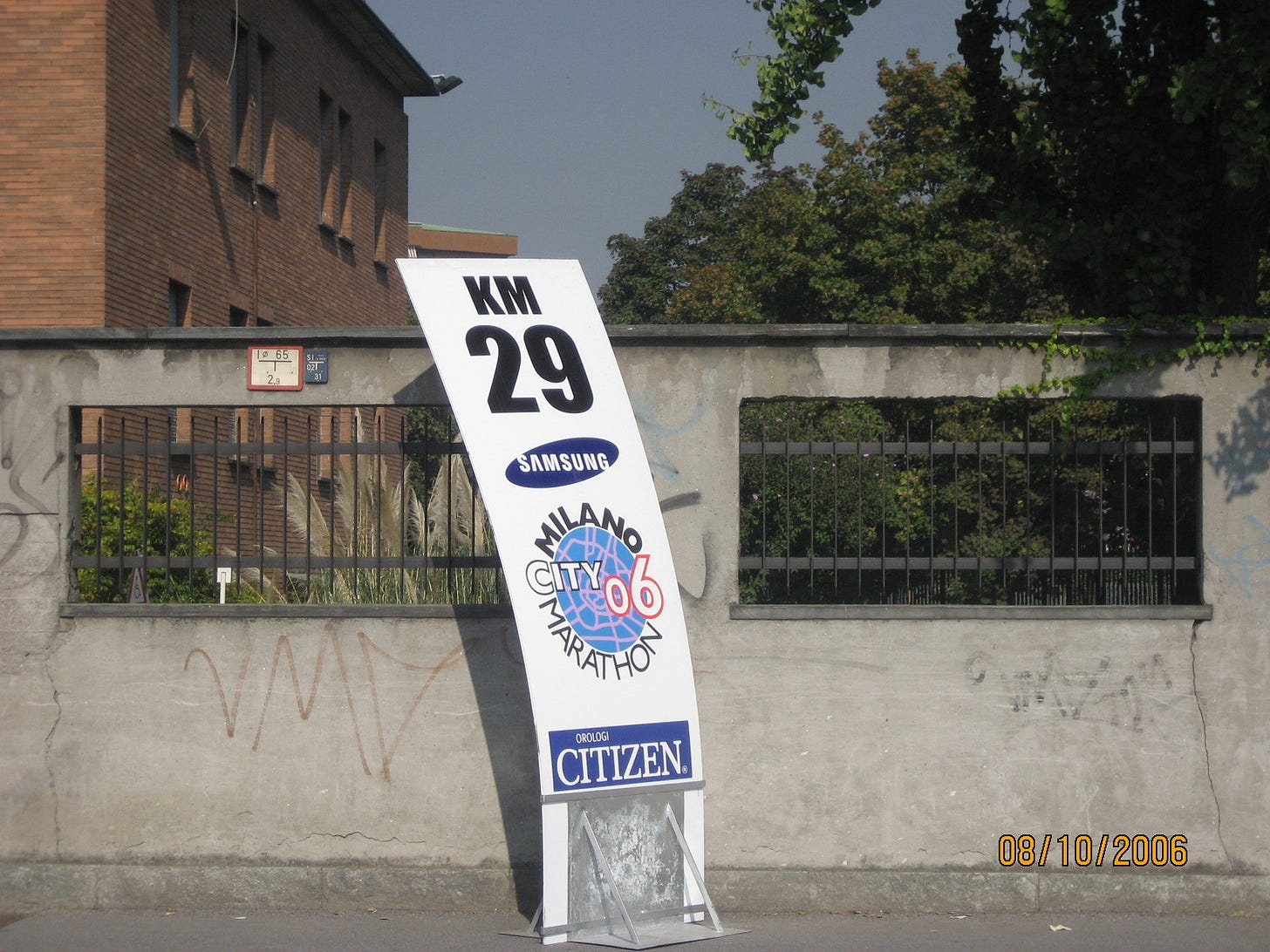

Adrenaline, audacity and stupidity... sounds like the brain of a go getter. Someone he dreams and accomplishes.
Proud of you dad.
Maybe next you should tell everyone about your Vespa 😉
Tino, your accomplishments and adventures are inspirational.